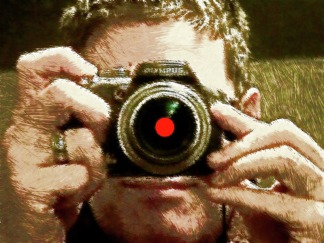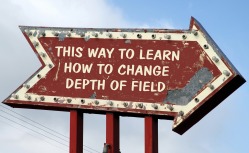ANSWER to Depth of Field question:
How do small holes or “apertures” relate to depth of field?

The story about Ronald Reagan and his military eye examination reminds us that when one looks through tiny round holes, things in the distance appear clearer, even for people with poor far sight vision. It therefore reasons that decreasing the "aperture" or opening in a camera's lens will have a corresponding effect on increasing the clarity of things that are farther from the camera.
You learned in Lesson 2, Part 5, that all SLR, DSLR and even some high-end point-and-shoot digital cameras allow for full manual control of exposure variables. This includes control of the "f-stop" as it relates to the size of the lens aperture. If a photographer wishes to photograph a subject that is fairly close to the lens, yet also have the distant background appear recognizable and fairly clear, then a small aperture should be used as a priority.
Remember that f-stops of 1.8, 2 and 4 represent very wide lens apertures, while f-stops of 16 and 22 represent very narrow lens apertures. Thus, when Long Depth of Field is required, the photographer's priority should be to choose the highest f-stop number possible according to the light meter.
Similarly, if the photographer wishes to take a portrait in which the subject is clear, but the background is characterized by "bokeh" (an appealing and artistic blur), then a very low f-stop number is in order. This would provide Short Depth of Field.
There's much more to learn about other techniques you can apply to your photography in order to influence long and short depth of field.
You learned in Lesson 2, Part 5, that all SLR, DSLR and even some high-end point-and-shoot digital cameras allow for full manual control of exposure variables. This includes control of the "f-stop" as it relates to the size of the lens aperture. If a photographer wishes to photograph a subject that is fairly close to the lens, yet also have the distant background appear recognizable and fairly clear, then a small aperture should be used as a priority.
Remember that f-stops of 1.8, 2 and 4 represent very wide lens apertures, while f-stops of 16 and 22 represent very narrow lens apertures. Thus, when Long Depth of Field is required, the photographer's priority should be to choose the highest f-stop number possible according to the light meter.
Similarly, if the photographer wishes to take a portrait in which the subject is clear, but the background is characterized by "bokeh" (an appealing and artistic blur), then a very low f-stop number is in order. This would provide Short Depth of Field.
There's much more to learn about other techniques you can apply to your photography in order to influence long and short depth of field.
Click Below to Return to the Depth of Field Lesson
© FreePhotoCourse.com. All rights reserved. Reproduction, storage, copying, publishing, manipulation, digitizing or selling of any of the text or photos on this website is strictly prohibited. Under no circumstances shall any part of the content on this website be plagiarized or referenced as the work of an author or photographer. Re-selling of any of the content on this site is strictly prohibited. The lessons on this website were provided free of charge for individual home users; if you paid for any of this you have been cheated. Please report any misuse, sale or plagiarism of this material here OR E-MAIL US AT: CONTACT@FREEPHOTOCOURSE.COM
Browse, learn, purchase and explore with confidence.
Certified virus-free, malware-free, spyware-free, scam-free and spam-free.
Associate-Sponsor Disclosure Content Download & Terms of Use Privacy Policy Contact Us Contributor's Gallery Terms of Use Forum Terms of Use
Certified virus-free, malware-free, spyware-free, scam-free and spam-free.
Associate-Sponsor Disclosure Content Download & Terms of Use Privacy Policy Contact Us Contributor's Gallery Terms of Use Forum Terms of Use

